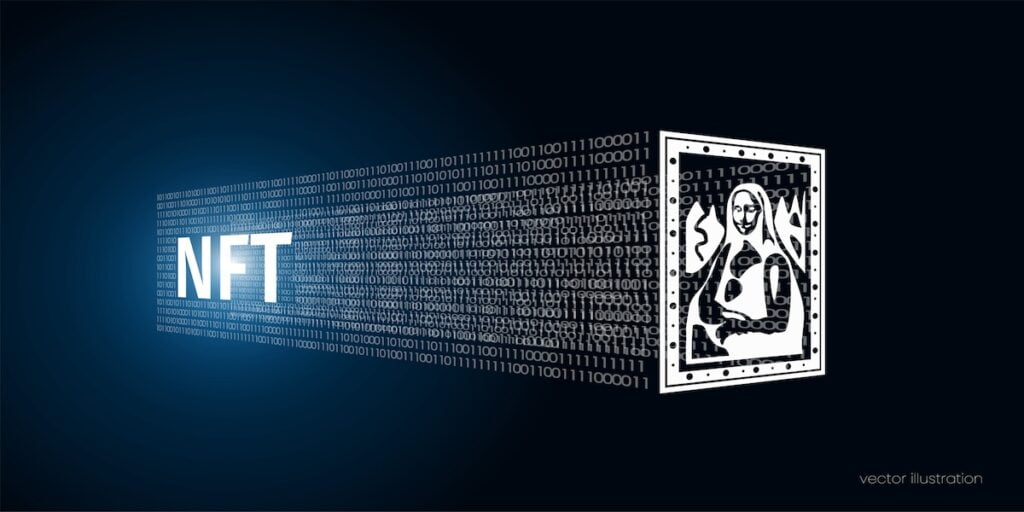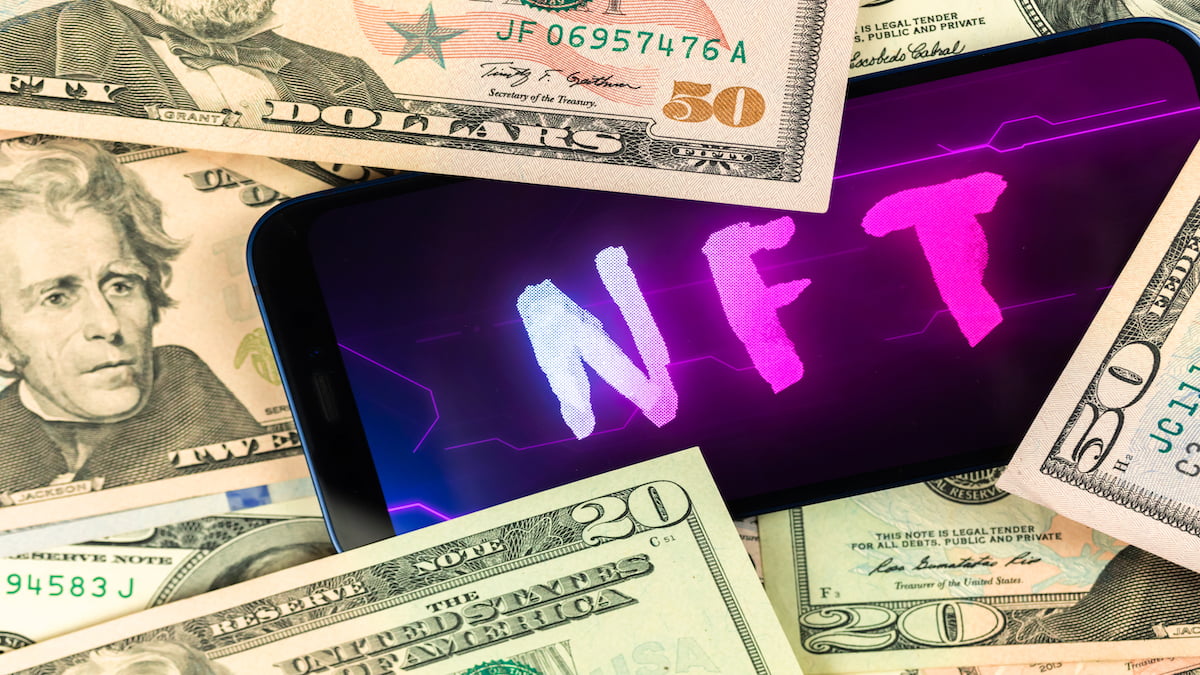Navigating the world of Non-Fungible Tokens (NFTs) can be a complex endeavour. Especially when it comes to selling these unique digital assets. This article aims to demystify the process. It provides actionable tips and strategies to help you successfully sell NFTs.
From understanding blockchain art to leveraging NFT auctions, we’ll cover it all. Whether you’re a digital artist, collector, or investor, this guide is for you. So, let’s delve into the fascinating world of NFTs and explore how you can maximize your success in this burgeoning marketplace.
Understanding NFTs and Blockchain Art
NFTs are a type of digital asset that is stored securely on a blockchain network. Unlike cryptocurrencies like Bitcoin, each NFT is unique and cannot be exchanged in a one-to-one manner. This uniqueness is what sets NFTs apart, as they can represent anything from artwork to collectibles to virtual real estate.
The emergence of blockchain art, a subcategory of NFTs, has had a profound impact on the art world. Artists now have the ability to tokenize their creations, essentially creating a digital certificate of ownership that can be bought, sold, and traded. This newfound technology has not only provided artists with a new way to showcase and monetize their work, but it has also transformed the way collectors engage with and acquire art. Furthermore, it has helped to level the playing field in the art market, making it more accessible and inclusive to a wider audience.
Source: Depositphotos
Preparing Your NFT for Sale
Before beginning the process of selling an NFT, it is essential to first create it through a procedure known as minting. Minting involves the crucial step of uploading your digital asset onto a designated NFT marketplace where it is transformed into a unique token on the blockchain. This process essentially immortalizes your digital creation in the form of a non-fungible token that can then be bought, sold, or traded within the digital marketplace.
Selecting the appropriate marketplace for your NFT is a critical decision that can greatly impact the success of your sale. Each NFT platform caters to different types of digital assets and artworks, and therefore it is essential to consider factors such as target audience, fee structures, and overall visibility. Furthermore, understanding the specific requirements and limitations of each marketplace can help in maximizing the value and reach of your NFT in the digital marketplace.
Minting Your Digital Asset
Minting an NFT is a process that involves creating a unique smart contract on the blockchain, a decentralized digital ledger that records transactions across a network of computers. This smart contract is essentially a self-executing contract with the terms of the NFT encoded within it. These terms typically include details such as the NFT’s name, description, and the digital file that represents the NFT.
When it comes to minting NFTs, the Ethereum blockchain is currently the most popular choice among creators and collectors. This is largely due to Ethereum’s robust smart contract capabilities, which allow for the creation of complex decentralized applications, including NFTs. However, other blockchains are also beginning to gain traction in the NFT space. For example, the Binance Smart Chain, a blockchain platform developed by the cryptocurrency exchange Binance, is becoming increasingly popular for minting NFTs due to its lower transaction fees and faster processing times. Additionally, the Flow blockchain, created by the team behind the popular NBA Top Shot NFT marketplace, is also emerging as a viable option for minting NFTs.
Pricing Strategies for NFTs
Pricing an NFT can be a daunting task as there is no standard pricing structure established for these digital assets, unlike traditional art pieces. The ever-evolving nature of the NFT market makes it difficult to determine the true value of these unique tokens. This lack of clarity can make it challenging for artists and creators to confidently price their NFTs for sale.
To navigate this complex landscape, there are several strategies that artists can employ to help determine a fair price for their NFTs. One approach is to research similar NFTs that have been sold in the past to gain a better understanding of the current market prices. This can provide valuable insights into what collectors are willing to pay for similar digital assets and help artists make informed pricing decisions.
In addition to considering market prices, artists should also take into account the costs associated with minting and selling their NFT. These costs can vary depending on the platform used to mint the NFT and any associated transaction fees. By factoring in these expenses, artists can ensure that they are pricing their NFTs in a way that covers their costs and allows them to make a profit from their work.
Another important factor to consider when pricing an NFT is the artist’s reputation and following within the NFT community. Artists with a strong reputation and a large following may be able to command higher prices for their NFTs, as collectors may place a higher value on their work. By taking into account their reputation and following, artists can better understand the demand for their NFTs and set prices accordingly.
Finally, artists should also consider the uniqueness and rarity of their NFT when determining a price. NFTs that are one-of-a-kind or part of a limited edition collection may be more valuable to collectors, as they are seen as exclusive and rare. By highlighting the unique aspects of their NFT, artists can justify higher prices and attract collectors who are willing to pay a premium for these special digital assets.

Source: Depositphotos
Choosing the Right NFT Auction Platform
Selecting the right platform to sell your NFT is crucial as it can greatly impact the success of your sale. Each platform out there offers its own unique set of features, audience reach, and fee structure. It is important to do thorough research on each platform to fully understand what they have to offer and how they can benefit you as an NFT seller.
There are several well-known platforms in the NFT space that you can consider, such as OpenSea, Rarible, and Foundation. These platforms have established themselves as leaders in the industry and have a wide range of artists and collectors using their services. However, it is essential to delve deeper into each platform and evaluate which one aligns best with your goals and the type of NFT you are looking to sell. By understanding the differences between these platforms, you can make an informed decision on where to list your NFT for maximum exposure and success.
Fixed-Price vs. Auction-Based Sales
When selling an NFT, there are two main methods you can choose from: a fixed price sale or an auction. Each method has its own set of advantages and disadvantages that you’ll need to consider before making a decision.
Opting for a fixed-price sale can provide you with a sense of certainty and control over the selling process. You’ll know exactly how much you’ll receive for your NFT without any surprises. However, there is a risk that you may undervalue your NFT and potentially miss out on higher offers that could have been obtained through an auction.
On the other hand, auctions can be an exciting way to potentially secure a higher price for your NFT as interested buyers compete against each other. This competitive nature can drive up the final selling price and result in a better return for the seller. However, auctions also come with the risk of not attracting any bids, leaving you with no sale at all. It’s important to weigh these pros and cons carefully when deciding which method is best for your NFT sale.
Marketing Your NFT
Marketing plays a crucial role in the success of selling your NFT. A well-thought-out and effectively executed marketing strategy has the potential to not only attract potential buyers but also increase the overall value of your NFT in the marketplace.
When showcasing your NFT, it’s important to consider the narrative behind it. A captivating story or background information can add depth and appeal to your NFT, making it more attractive to potential buyers who may be drawn to the unique story behind the creation.
Building a Personal Brand
In the world of NFTs, building a strong personal brand is essential. By establishing a distinct and memorable personal brand, you can enhance your credibility within the NFT community and differentiate yourself from other artists and creators.
A successful personal brand should authentically reflect your individual style and values. It should resonate with your target audience, creating a connection that makes them eager to own a piece of your work and support your artistic endeavors.
Leveraging Social Media
Utilizing social media platforms can significantly amplify the reach of your NFT marketing efforts. Platforms like Twitter and Instagram provide a global stage to showcase your work, engage with followers, and attract potential buyers from all corners of the world.
By regularly sharing updates about your creative process, engaging with your audience, and utilizing relevant hashtags to increase visibility, you can leverage social media as a powerful tool to build a strong online presence and cultivate a loyal following of NFT enthusiasts. Remember, genuine engagement with your audience is key to establishing a meaningful and impactful presence on social media platforms.

Source: Depositphotos
Legal and Ethical Considerations
Selling NFTs requires careful consideration of both legal and ethical implications. It is essential for individuals engaging in this practice to have a thorough understanding of intellectual property rights in order to prevent any potential legal disputes that may arise. By ensuring that they have the proper authorization to sell the NFTs they are offering, sellers can protect themselves from legal repercussions and maintain credibility within the market.
In addition to legal considerations, sellers of NFTs must also take into account the environmental impact of their actions. The use of blockchain technology in the creation and sale of NFTs consumes a significant amount of energy, leading to concerns about its sustainability and environmental implications. As a responsible seller, it is crucial to be aware of these issues and take steps to minimize the negative impact on the environment. This may include exploring alternative blockchain solutions or offsetting energy usage through sustainable practices. By addressing these concerns proactively, sellers can demonstrate their commitment to ethical and sustainable business practices.
Maximizing Success in the NFT Marketplace
Successfully selling NFTs in today’s competitive market requires more than just luck. It demands a carefully thought out strategic plan that takes into account factors such as current market trends, buyer preferences, and emerging technologies. By staying informed on the latest developments in the NFT marketplace, sellers can better position themselves to succeed and stand out among the competition.
In addition to having a solid strategy in place, effective marketing is crucial for promoting NFTs and reaching a wider audience. Utilizing social media platforms, email marketing, and partnerships with influencers can help generate buzz and drive interest in the NFTs being sold. Building a strong online presence and engaging with the community can also help establish credibility and trust with potential buyers.
Transparency and trust are essential components of a successful NFT selling strategy. Buyers are more likely to invest in NFTs when they feel confident in the legitimacy and authenticity of the seller. By being open and honest about the creation and ownership of NFTs, sellers can build a loyal customer base and ensure repeat business. Prioritizing transparency and trust can go a long way in establishing a positive reputation in the NFT marketplace.
Credit: Source link
































